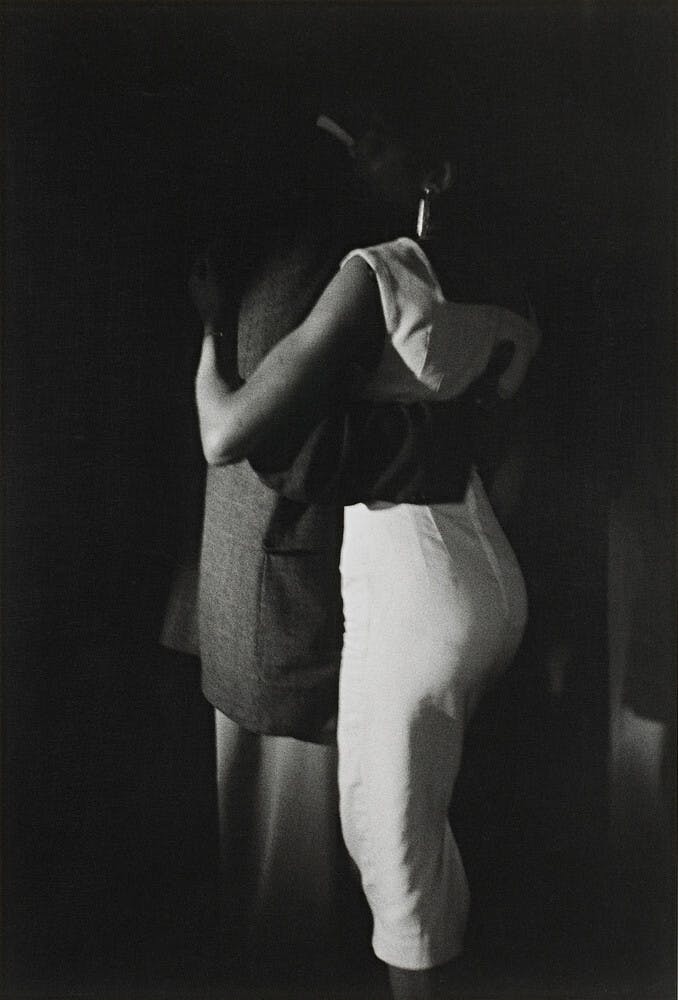Roy DeCarava
(1919–2009)Roy DeCarava photographed the streets of Harlem, capturing images of the civil rights movement, jazz scenes, and the urban landscape.
Biography
Born and raised in Harlem, photographer Roy DeCarava first studied art in New York City’s public schools. After a stint making prints and paintings in the poster division of the Works Progress Administration, he studied at Cooper Union, Harlem Community Art Center, and George Washington Carver Art School. Originally purchasing a camera to gather visual information for his paintings, he began to exclusively use photography as a means of artistic expression in the mid-1940s. He photographed the streets of Harlem, capturing images of the civil rights movement, jazz scenes, and the urban landscape. He imbued his subjects with power, elegance, and grace to contradict how, according to DeCarava, Black people were “not being portrayed in a serious and artistic way.”1
DeCarava became the first Black photographer to win a John Simon Guggenheim Memorial Fellowship, in 1952. During the fellowship, he compiled a set of photos of Harlem. From the set, Langston Hughes selected 141 and supplied a narrative from the perspective of Sister Mary Bradley, a Black woman living in Harlem. This project became The Sweet Flypaper of Life (1955), a book that would go on to become a classic of photographic visual literature. In 1955, DeCarava opened A Photographer’s Gallery—the first gallery in the United States to expressly exhibit American fine art silver gelatin photography. The space remained open for two years, during which time he presented solo exhibitions of his work and exhibitions of emerging American photographers such as Bernice Abbott, Harry Callahan, and Minor White.
During his lifetime, DeCarava received numerous awards, including a National Medal of Arts, the high civilian honor awarded by the National Endowment for the Arts and presented by the President of the United States. The Studio Museum presented two solo exhibitions of DeCarava’s work: Thru Black Eyes: Photographs by Roy DeCarava (1969); and The Sound I Saw: The Jazz Photographs of Roy DeCarava (1983), in addition to including his work in numerous group exhibitions.
1) Roberta Smith, “The Photographer Who Found His Power in Shades of Gray,” New York Times, October 10, 2019, nytimes.com/a/10/10/arts/design/roy-decarava-photography-david-zwirner.html.
Roy DeCarava
(1919–2009)Roy DeCarava photographed the streets of Harlem, capturing images of the civil rights movement, jazz scenes, and the urban landscape.
Couple Dancing, 1956
Biography
Born and raised in Harlem, photographer Roy DeCarava first studied art in New York City’s public schools. After a stint making prints and paintings in the poster division of the Works Progress Administration, he studied at Cooper Union, Harlem Community Art Center, and George Washington Carver Art School. Originally purchasing a camera to gather visual information for his paintings, he began to exclusively use photography as a means of artistic expression in the mid-1940s. He photographed the streets of Harlem, capturing images of the civil rights movement, jazz scenes, and the urban landscape. He imbued his subjects with power, elegance, and grace to contradict how, according to DeCarava, Black people were “not being portrayed in a serious and artistic way.”1
DeCarava became the first Black photographer to win a John Simon Guggenheim Memorial Fellowship, in 1952. During the fellowship, he compiled a set of photos of Harlem. From the set, Langston Hughes selected 141 and supplied a narrative from the perspective of Sister Mary Bradley, a Black woman living in Harlem. This project became The Sweet Flypaper of Life (1955), a book that would go on to become a classic of photographic visual literature. In 1955, DeCarava opened A Photographer’s Gallery—the first gallery in the United States to expressly exhibit American fine art silver gelatin photography. The space remained open for two years, during which time he presented solo exhibitions of his work and exhibitions of emerging American photographers such as Bernice Abbott, Harry Callahan, and Minor White.
During his lifetime, DeCarava received numerous awards, including a National Medal of Arts, the high civilian honor awarded by the National Endowment for the Arts and presented by the President of the United States. The Studio Museum presented two solo exhibitions of DeCarava’s work: Thru Black Eyes: Photographs by Roy DeCarava (1969); and The Sound I Saw: The Jazz Photographs of Roy DeCarava (1983), in addition to including his work in numerous group exhibitions.
1) Roberta Smith, “The Photographer Who Found His Power in Shades of Gray,” New York Times, October 10, 2019, nytimes.com/a/10/10/arts/design/roy-decarava-photography-david-zwirner.html.


